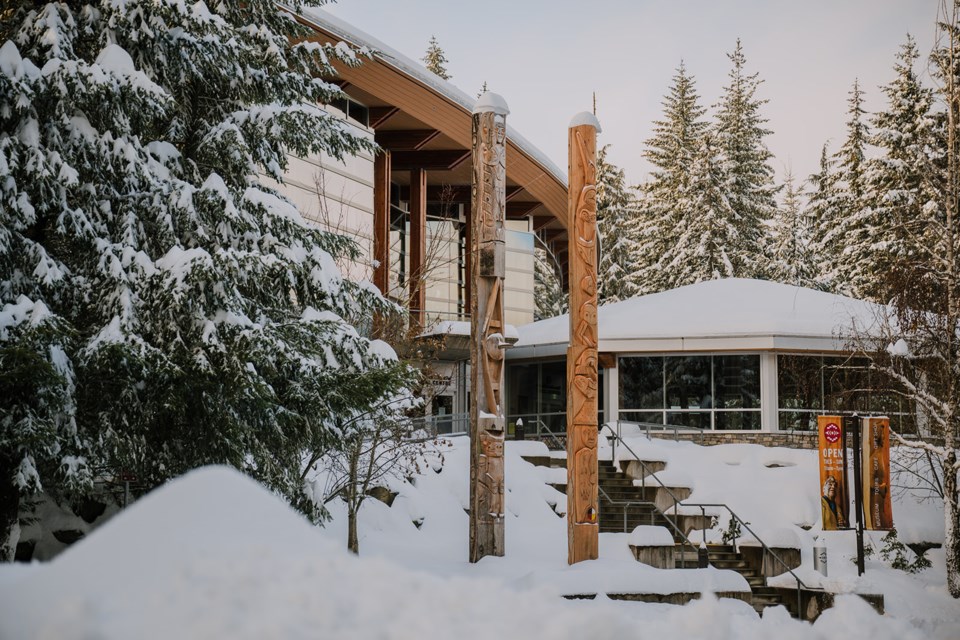It’s been 15 years since the storyboards at the Squamish Lil’wat Cultural Centre (SLCC) were updated, but this spring, the centre is getting a refresh.
Alison Pascal (Mixalhi虂tsa7) has spent the last year consulting with Squamish and Lil’wat Nation community members, engaging in a cultural review of all interpretive panels in the SLCC’s Great Hall. Pascal, a member of the Lil’wat Nation, said the community-centred process focused on ensuring community members were still happy with stories shared, discovering if there’s anything to be added or removed, or if there are new topics to include.
“Most of the feedback is positive," Pascal said. "The biggest requests were to add a variety of photos to show the continuance of the culture. When you think of a museum, it’s held in the past or stuck in the past. Our communities are living, breathing things, growing and changing as the land around us grows. We want to be acknowledged as still here, living and breathing and we will continue to do so."
The SLCC sought feedback from seniors, adults, youth and children. Because the SLCC is at least an hour away from the Squamish and Lil’wat Nation communities, Pascal said that proved a barrier to full participation by elder community members in engagement sessions.
Most of the feedback for the current exhibit was positive, but there was a request to remove one photo containing a carving from public view.
A language audit was also part of the process, with Nation representatives editing and updating the spelling of Squamish and Lil’wat languages to ensure accuracy. Originally, the Skwxwú7mesh Sníchim, (Squamish Language) was only a spoken language, and a written record was first developed in 1967. Colonization erased much of Indigenous language through residential school systems, which banned children speaking their language while removing them from their homes. Pascal said the Squamish Nation is actively working to revive fluency.
“They’ve done a lot of work creating opportunities for Nation members to learn their language, and the work is updating the old style to match the new style,” Pascal said.
Some changes include the layout and colours of interpretive panels. For photos, Pascal said she looked at archived material and current pictures at the centre, and for community photo submissions.
Repatriated Squamish art
The updated display will feature repatriated items incorporated into the refresh. The SLCC will have 16 pieces of artwork repatriated from the Canadian Museum of History (CMH). Repatriation is the return of cultural items, “without condition,”. The museum does so at its own expense, and communities of origin determine how to house them.
Many museums in Canada and around the world have items from Indigenous communities or from other cultures that were removed through questionable means. Repatriation policies differ based on the museum. For example, the, which bars museum trustees from returning items.
Pique reached out to CMH but did not hear back by publication time.
Pascal said the Squamish Nation has worked for a few years to have CMH return artwork associated with master weaver Skwetsiya (Mrs. Harriet Johnnie) and her husband, George Johnnie. Items slated for repatriation include fishing tools, tools for food preparation and items for Salish mountain goat wool weaving.
CMH also when she was about 88 years old that will be shown at the SLCC.
“Harriet was one of the last master wool weavers of the Squamish Nation, and the video was produced in 1928. After she passed away, there was a lack of weaving until hereditary Chief Janice,” Pascal said.
Chief Janice George is a Squamish hereditary chief, and she and her husband Willard "Buddy" Joseph co-founded L’hen Awtxw Weaving House to teach Salish wool weaving after learning it themselves.
CMH will send the items by ground, and they’re expected to arrive in the last week of January. The difference in climate between Gatineau, Que., where CMH is, and Whistler, is so different Pascal said the items will sit for a period in their case to acclimate. Then, the Squamish Nation will hold a ceremony to welcome them back home.
A celebration for the storyboard and the item repatriation is planned for spring and will be open to the public.
The final proofing is slated for the end of March, and the installation is slated for April.
Check back with Pique for more on the artwork repatriation in the coming weeks.



